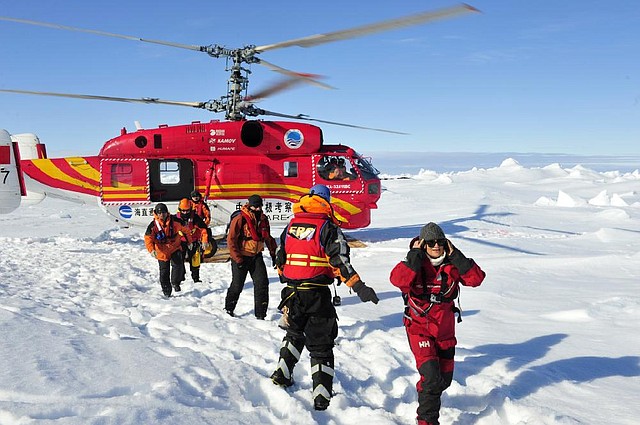52 on ship in Antarctic rescued
Helicopter ferries out passengers trapped since Dec. 24
The first group of passengers from the trapped Russian ship MV Akademik Shokalskiy exit a Chinese rescue helicopter Thursday in this photo provided by China’s Xinhua News Agency.
Friday, January 3, 2014
CANBERRA, Australia - All 52 passengers trapped for more than a week on an icebound Russian research ship in the Antarctic were rescued Thursday when a Chinese helicopter swooped in and plucked them from the ice a dozen at a time.
The international rescue operation became possible once the weather finally cleared. Blinding snow, strong winds, fog and thick sea ice forced rescuers to turn back time and again since Christmas Eve, when the vessel became trapped.
The twin-rotor helicopter - its red and yellow colors contrasting starkly against the ice and snow - carried the scientists and tourists from the Russian ship MV Akademik Shokalskiy to an Australian icebreaker, according to the Australian Maritime Safety Authority’s Rescue Coordination Center, which oversaw the rescue.
At one point, the passengers linked arms and stamped out a landing site in the snow next to the Russian ship for the helicopter, which is based on a Chinese icebreaker.
The icebreaker Aurora Australis will take the passengers to the Australian island state of Tasmania, a journey expected to last two weeks.
“I think everyone is relieved and excited to be going onto the Australian icebreaker and then home,” expedition leader Chris Turney said by satellite phone from the Antarctic.
The 22 crew members of the Akademik Shokalskiy stayed with the icebound vessel, which is not in danger of sinking and has enough supplies on board to last for weeks. They will wait until the ice that surrounds the ship breaks up.
The Akademik Shokalskiy, which left New Zealand on Nov. 28, got stuck after a blizzard pushed the sea ice around the ship, freezing it in place about 1,700 miles south of Hobart, Tasmania.
Three icebreakers were dispatched to try to crack their way through the ice surrounding the Russian ship, but all three failed. The Aurora came within 12 miles of the ship Monday, but fierce winds and snow forced it to retreat to open water.
On Thursday, it initially appeared the weather had thwarted yet another rescue attempt. The helicopter originally was going to carry the passengers back to the Chinese icebreaker, the Snow Dragon, with a barge, then ferrying them to the Aurora. But sea ice prevented the barge from reaching the Chinese vessel, and the maritime authority said the operation would have to be delayed.
A last-minute change in plans allowed the rescue to go ahead.
The passengers were instead flown to an ice floe next to the Aurora and then taken by a small boat to the Australian ship, Turney said.
The scientific team on board the Russian vessel had been re-creating Australian explorer Douglas Mawson’s1911 to 1913 voyage to Antarctica.
Turney had hoped to continue the trip if an icebreaker managed to free the ship. Despite his disappointment over the expedition being cut short, he said his spirits remained high.
“I’m a bit sad it’s ended this way,” he said. “But we got lots and lots of great science done.”
China has an interest in Antarctica, with the growing scientific power recently beginning construction on its fourth Antarctic research base.
Information for this article was contributed by Kristen Gelineau and Seth Borenstein of The Associated Press.
Front Section, Pages 2 on 01/03/2014
